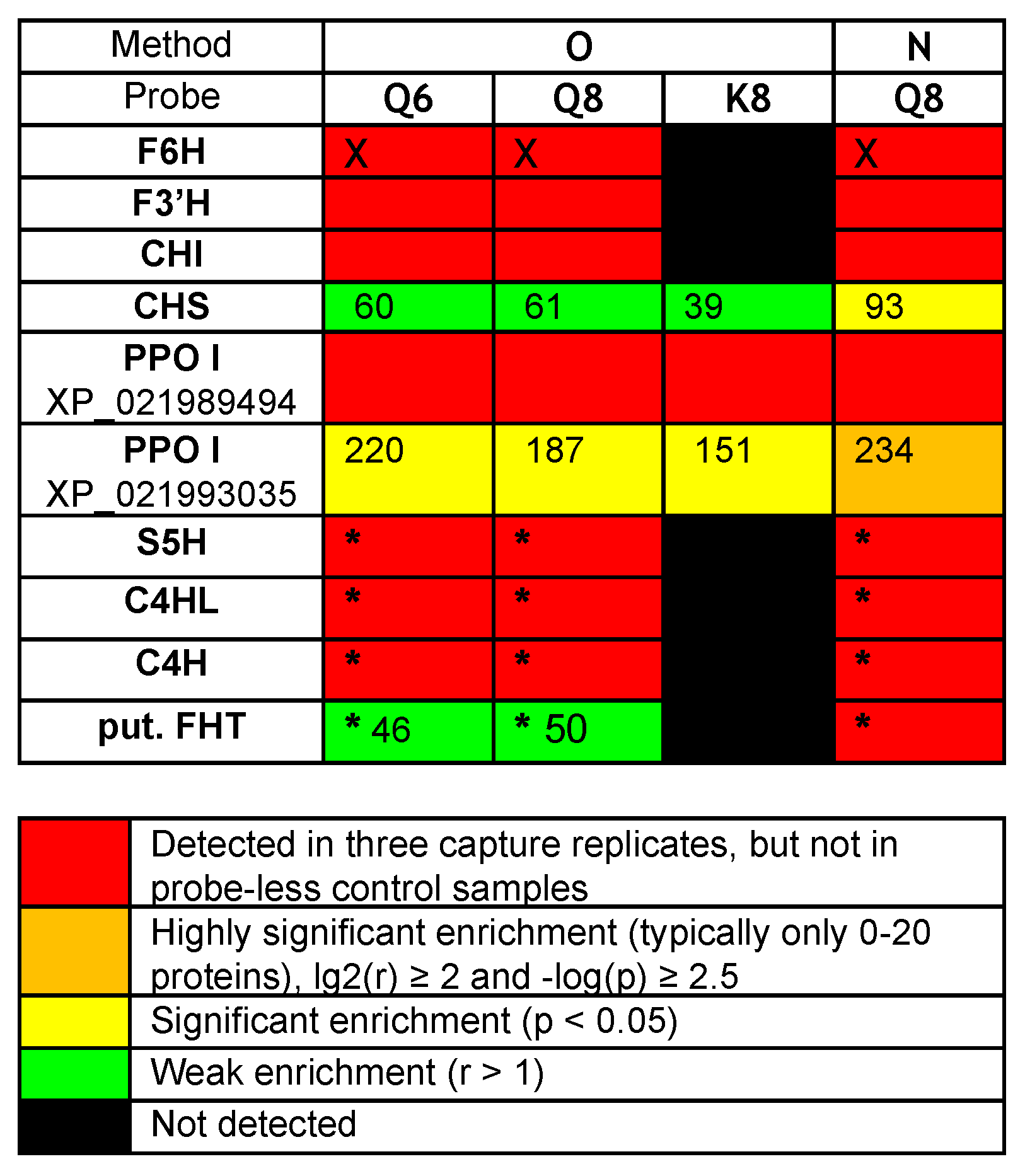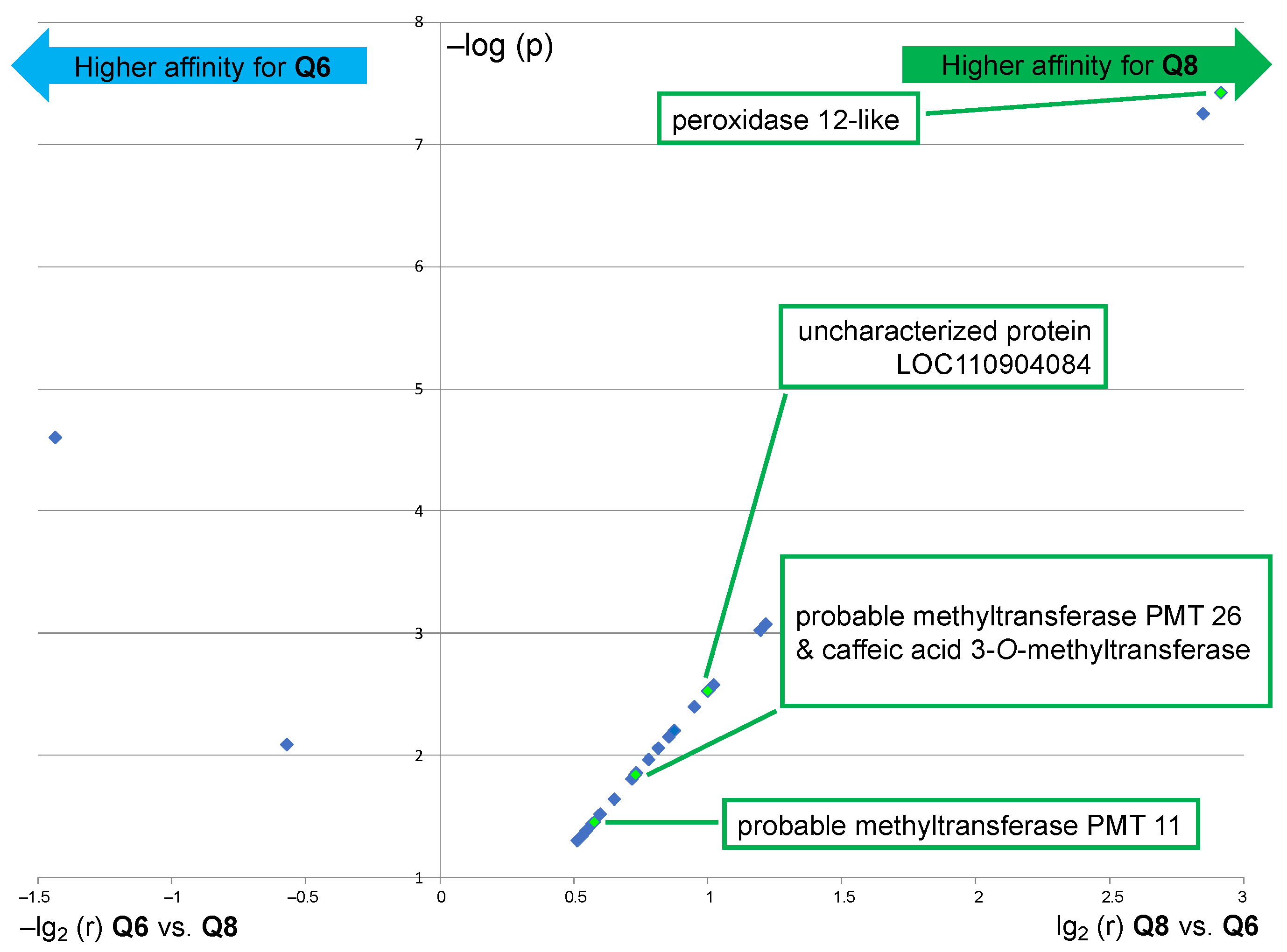Synthesis of Flavonol-Bearing Probes for Chemoproteomic and Bioinformatic Analyses of Asteraceae Petals in Search of Novel Flavonoid Enzymes
Abstract
:1. Introduction
2. Results and Discussion
2.1. Chemical Synthesis of Quercetin-Bearing Probes
2.2. Affinity-Based (Covalent) Capture of Asteraceae Proteins
2.3. Proteomic and Bioinformatic Analyses of Proteins Captured from Rudbeckia Hirta
2.4. Proteomic-Based Bioinformatic Search of Novel Flavonoid Enzymes in Rudbeckia Hirta and Tagetes Erecta
2.5. BlastP-Based Bioinformatic Search of Rudbeckia Flavonol Hydroxylases
3. Materials and Methods
3.1. Microsomal Protein Extraction
3.2. Affinity-Based (Covalent) Protein Capture Assays
3.3. Label-Free Quantitative Shotgun Proteomics
3.4. Bioinformatics
4. Conclusions
Supplementary Materials
Author Contributions
Funding
Institutional Review Board Statement
Informed Consent Statement
Data Availability Statement
Acknowledgments
Conflicts of Interest
References
- Harborne, J.B.; Williams, C.A. Advances in flavonoid research since 1992. Phytochemistry 2000, 55, 481–504. [Google Scholar] [CrossRef] [PubMed]
- Harborne, J.B. Introduction to Ecological Biochemistry, 4th ed.; Academic Press: London, UK, 1993. [Google Scholar]
- Thompson, W.R.; Meinwald, J.; Aneshansley, D.; Eisner, T. Flavonols: Pigments responsible for ultraviolet absorption in nectar guide of flower. Science 1972, 177, 528–530. [Google Scholar] [CrossRef] [PubMed]
- Halbwirth, H.; Wurst, F.; Forkmann, G.; Stich, K. Biosynthesis of yellow flower pigments belonging to flavonoids and related compounds. In Research Advances in Phytochemistry; Mohan, R.M., Ed.; Global Research Network: Kerala, India, 2000; Volume 1, pp. 35–49. [Google Scholar]
- Schlangen, K.; Miosic, S.; Castro, A.; Freudmann, K.; Luczkiewicz, M.; Vitzthum, F.; Schwab, W.; Gamsjäger, S.; Musso, M.; Halbwirth, H. Formation of UV-honey guides in Rudbeckia hirta. Phytochemistry 2009, 70, 889–898. [Google Scholar] [CrossRef] [PubMed]
- Halbwirth, H.; Forkmann, G.; Stich, K. The A-ring specific hydroxylation of flavonols in position 6 in Tagetes sp. is catalyzed by a cytochrome P450 dependent monooxygenase. Plant Sci. 2004, 167, 129–135. [Google Scholar] [CrossRef]
- Halbwirth, H.; Stich, K. An NADPH and FAD dependent enzyme catalyzes hydroxylation of flavonoids in position 8. Phytochemistry 2006, 67, 1080–1087. [Google Scholar] [CrossRef]
- Anzelloti, D.; Ibrahim, R.K. Novel flavonol 2-oxoglutarate dependent dioxygenase: Affinity purification, characterization, and kinetic properties. Arch. Biochem. Biophys. 2000, 382, 161–172. [Google Scholar] [CrossRef]
- Anzelloti, D.; Ibrahim, R.K. Molecular characterization and functional expression of flavonol 6-hydroxylase. BMC Plant Biol. 2004, 4, 20. [Google Scholar] [CrossRef] [Green Version]
- Latunde-Dada, A.O.; Cabello-Hurtado, F.; Czittrich, N.; Didierjean, L.; Schopfer, C.; Hertkorn, N.; Werck-Reichhart, D.; Ebel, J. Flavonoid 6-hydroxylase from soybean (Glycine max L.), a novel plant P-450 monooxygenase. J. Biol. Chem. 2001, 276, 1688–1695. [Google Scholar] [CrossRef] [Green Version]
- Hiraga, Y.; Shimada, N.; Nagashima, Y.; Suda, K.; Kanamori, T.; Ishiguro, K.; Sato, Y.; Hirakaw, H.; Sato, S.; Akashi, T.; et al. Identification of a flavin monooxygenase-like flavonoid 8-hydroxylase with gossypetin synthase activity from Lotus japonicus. Plant Cell Physiol. 2021, 62, 411–423. [Google Scholar] [CrossRef]
- Jeffery, D.A.; Bogyo, M. Chemical proteomics and its application to drug discovery. Curr. Opin. Biotechnol. 2003, 14, 87–95. [Google Scholar] [CrossRef]
- Evans, M.J.; Cravatt, B.F. Mechanism-based profiling of enzyme families. Chem. Rev. 2006, 106, 3279–3301. [Google Scholar] [CrossRef]
- Carlson, E.E. Natural products as chemical probes. ACS Chem. Biol. 2010, 5, 639–653. [Google Scholar] [CrossRef] [Green Version]
- Carrié, H.; Tran, D.T.; Rousseau, S.; Chaignepain, S.; Schmitter, J.-M.; Deffieux, D.; Quideau, S. New affinity-based probes for capturing flavonoid-binding proteins. Chem. Commun. 2014, 50, 9387–9389. [Google Scholar] [CrossRef]
- Delannoy López, D.M.; Tran, D.T.; Viault, G.; Dairi, S.; Peixoto, P.A.; Capello, Y.; Minder, L.; Pouységu, L.; Génot, E.; Di Primo, C.; et al. Real-time analysis of polyphenol–protein interactions by surface plasmon resonance using surface-bound polyphenols. Chem. Eur. J. 2021, 27, 5498–5508. [Google Scholar] [CrossRef]
- Karimovaa, E.R.; Spirikhin, L.V.; Baltina, L.A.; Abdullin, M.I. Synthesis and identification of quercetin benzyl ethers. Russ. J. Gen. Chem. 2014, 84, 1711–1715. [Google Scholar] [CrossRef]
- Racys, D.T.; Sharif, S.A.I.; Pimlott, S.L.; Sutherland, A. Silver(I)-catalyzed iodination of arenes: Tuning the Lewis acidity of N-iodosuccinimide activation. J. Org. Chem. 2016, 81, 772–780. [Google Scholar] [CrossRef] [Green Version]
- Lu, K.; Chu, J.; Wang, H.; Fu, X.; Quan, D.; Ding, H.; Yao, Q.; Yu, P. Regioselective iodination of flavonoids by N-iodosuccinimide under neutral conditions. Tetrahedron Lett. 2013, 54, 6345–6348. [Google Scholar] [CrossRef]
- Tee, J.T.; Keane, T.; Meijer, A.J.H.M.; Khaledi, H.; Rahman, N.A.; Chee, C.F. A strategy toward the biomimetic synthesis of (±)-morusalbanol A pentamethyl Ether. Synthesis 2016, 48, 2263–2270. [Google Scholar] [CrossRef]
- Chalumeau, C.; Deffieux, D.; Chaignepain, S.; Quideau, S. Development of an affinity-based proteomic strategy for the elucidation of proanthocyanidin biosynthesis. ChemBioChem 2011, 12, 1193–1197. [Google Scholar] [CrossRef]
- Yang, W.; Li, R.; Han, W.; Zhang, W.; Sun, J. Highly efficient synthesis of kaempferol-5-O-rhamnopyranoside. Chin. J. Org. Chem. 2012, 32, 1067–1071. [Google Scholar] [CrossRef] [Green Version]
- Tonomura, B.; Nakatani, H.; Ohnishi, M.; Yamaguchi-Ito, J.; Hiromi, K. Test reactions for a stopped-flow apparatus–Reduction of 2,6-dichlorophenolindophenol and potassium ferricyanide by L-ascorbic acid. Anal. Biochem. 1978, 84, 370–383. [Google Scholar] [CrossRef] [PubMed]
- Walsh, D.; Sanchez-Ballester, N.M.; Ting, V.P.; Ariga, K.; Weller, M.T. Visible light promoted photocatalytic water oxidation: Proton and electron collection via a reversible redox dye mediator. Catal. Sci. Technol. 2016, 6, 3718–3722. [Google Scholar] [CrossRef] [Green Version]
- Hermanson, G.T. Functional targets for bioconjugation. In Bioconjugate Techniques, 3rd ed.; Academic Press: Cambridge, UK, 2013; Chapter 2; pp. 127–228. [Google Scholar] [CrossRef]
- Proteomes-Helianthus annuus (Common sunflower). Available online: https://www.uniprot.org/proteomes/UP000215914 (accessed on 29 January 2021).
- Feng, G.; Huang, S.; Liu, Y.; Xiao, F.; Liu, J.; Zhang, Z.; Chen, Q.; Mao, Y.; Cao, X.; Wang, Y.; et al. The transcriptome analyses of Tagetes erecta provides novel insights into secondary metabolite biosynthesis during flower development. Gene 2018, 660, 18–27. [Google Scholar] [CrossRef] [PubMed]
- Altschul, S.F.; Madden, T.L.; Schäffer, A.A.; Zhang, J.; Zhang, Z.; Miller, W.; Lipman, D.J. Gapped BLAST and PSI-BLAST: A new generation of protein database search programs. Nucleic Acids Res. 1997, 25, 3389–3402. [Google Scholar] [CrossRef] [PubMed] [Green Version]
- Zhao, Q.; Cui, M.-Y.; Levsh, O.; Yang, D.; Liu, J.; Li, J.; Hill, L.; Yang, L.; Hu, Y.; Weng, J.-K.; et al. Two CYP82D enzymes function as flavone hydroxylases in the biosynthesis of root-specific 4’-deoxyflavones in Scutellaria baicalensis. Mol. Plant 2018, 11, 135–148. [Google Scholar] [CrossRef] [Green Version]
- van Rooden, E.J.; Florea, B.I.; Deng, H.; Baggelaar, M.P.; van Esbroeck, A.C.M.; Zhou, J.; Overkleeft, H.S.; van der Stelt, M. Mapping in vivo target interaction profiles of covalent inhibitors using chemical proteomics with label-free quantification. Nat. Protoc. 2018, 13, 752–767. [Google Scholar] [CrossRef]
- Liu, B.; Burdine, L.; Kodadek, T. Chemistry of periodate-mediated cross-linking of 3,4-dihydroxylphenylalanine-containing molecules to proteins. J. Am. Chem. Soc. 2006, 128, 15228–15235. [Google Scholar] [CrossRef] [Green Version]
- Lambeth, D.O.; Palmer, G. The kinetics and mechanism of reduction of electron transfer proteins and other compounds of biological interest by dithionite. J. Biol. Chem. 1973, 248, 6095–6103. [Google Scholar] [CrossRef]
- Petit, E.; Jacquet, R.; Pouységu, L.; Deffieux, D.; Quideau, S. Reactivity of wine polyphenols under oxidation conditions: Hemisynthesis of adducts between grape catechins or oak ellagitannins and odoriferous thiols. Tetrahedron 2019, 75, 551–560. [Google Scholar] [CrossRef]
- Weerapana, E.; Speers, A.E.; Cravatt, B.F. Tandem orthogonal proteolysis-activity-based protein profiling (TOP-ABPP)–a general method for mapping sites of probe modification in proteomes. Nat. Protoc. 2007, 2, 1414–1425. [Google Scholar] [CrossRef]
- Käll, L.; Canterbury, J.D.; Weston, J.; Noble, W.S.; MacCoss, M.J. Semi-supervised learning for peptide identification from shotgun proteomics datasets. Nat. Methods 2007, 4, 923–925. [Google Scholar] [CrossRef]
- Virtanen, P.; Gommers, R.; Oliphant, T.E.; Haberland, M.; Reddy, T.; Cournapeau, D.; Burovski, E.; Peterson, P.; Weckesser, W.; Bright, J.; et al. SciPy 1.0 Contributors. SciPy 1.0: Fundamental algorithms for scientific computing in Python. Nat. Method. 2020, 17, 261–272. [Google Scholar] [CrossRef] [Green Version]
- Altschul, S.F.; Gish, W.; Miller, W.; Myers, E.W.; Lipman, D.J. Basic local alignment search tool. J. Mol. Biol. 1990, 215, 403–410. [Google Scholar] [CrossRef]
- Perez-Riverol, Y.; Csordas, A.; Bai, J.; Bernal-Llinares, M.; Hewapathirana, S.; Kundu, D.J.; Inuganti, A.; Griss, J.; Mayer, G.; Eisenacher, M.; et al. The PRIDE database and related tools and resources in 2019: Improving support for quantification data. Nucleic Acids Res. 2019, 47, D442–D450. [Google Scholar] [CrossRef]







Disclaimer/Publisher’s Note: The statements, opinions and data contained in all publications are solely those of the individual author(s) and contributor(s) and not of MDPI and/or the editor(s). MDPI and/or the editor(s) disclaim responsibility for any injury to people or property resulting from any ideas, methods, instructions or products referred to in the content. |
© 2023 by the authors. Licensee MDPI, Basel, Switzerland. This article is an open access article distributed under the terms and conditions of the Creative Commons Attribution (CC BY) license (https://creativecommons.org/licenses/by/4.0/).
Share and Cite
Kempf, K.; Kempf, O.; Capello, Y.; Molitor, C.; Lescoat, C.; Melhem, R.; Chaignepain, S.; Génot, E.; Groppi, A.; Nikolski, M.; et al. Synthesis of Flavonol-Bearing Probes for Chemoproteomic and Bioinformatic Analyses of Asteraceae Petals in Search of Novel Flavonoid Enzymes. Int. J. Mol. Sci. 2023, 24, 9724. https://doi.org/10.3390/ijms24119724
Kempf K, Kempf O, Capello Y, Molitor C, Lescoat C, Melhem R, Chaignepain S, Génot E, Groppi A, Nikolski M, et al. Synthesis of Flavonol-Bearing Probes for Chemoproteomic and Bioinformatic Analyses of Asteraceae Petals in Search of Novel Flavonoid Enzymes. International Journal of Molecular Sciences. 2023; 24(11):9724. https://doi.org/10.3390/ijms24119724
Chicago/Turabian StyleKempf, Karl, Oxana Kempf, Yoan Capello, Christian Molitor, Claire Lescoat, Rana Melhem, Stéphane Chaignepain, Elisabeth Génot, Alexis Groppi, Macha Nikolski, and et al. 2023. "Synthesis of Flavonol-Bearing Probes for Chemoproteomic and Bioinformatic Analyses of Asteraceae Petals in Search of Novel Flavonoid Enzymes" International Journal of Molecular Sciences 24, no. 11: 9724. https://doi.org/10.3390/ijms24119724





